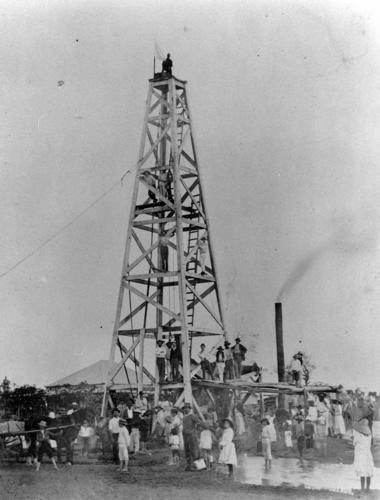17th December 1887 - a significant day for Queensland
By JOL Admin | 27 January 2015
Guest blogger: Thom Blake - John Oxley Library Fellow and historian

So what is special about that day? You will not find it mentioned in any histories of Queensland, list of significant dates or in the newspaper headlines for that day or week. But in the central western town of Barcaldine, an extraordinary event occurred that forever changed Queensland.
A Canadian drilling contractor, J.S. Loughead, had been engaged by J.B. Henderson, the Hydraulic Engineer for the Queensland government, to drill for water in Barcaldine. Barcaldine was a newly established town on the central western railway. It appeared to have a promising future as a railway centre, but lacked access to a good supply of water. Henderson had instructed Loughead to drill, not for water a few metres below the surface, but into the depths of the earth where potentially artesian water might exit.
In the previous decade, geologists and others had speculated on the presence of artesian water in inland Australia. Several attempts have been made to drill for artesian water - most unsuccessful. In 1878, artesian water was discovered at Bourke and in 1887 at Thurulgoona in south-west Queensland. J.S. Loughead had found a good supply of artesian water at a depth of 250 metres. But were these bores tapping isolated subterranean reservoirs or was there a vast supply? Loughead provided the answer, or at least compelling evidence to suggest there was indeed water aplenty.
Loughead commenced drilling on 16 November 1887 and just over a month later at a depth of 200 metres struck water. And it was not just a trickle. The water gushed out at a rate of about 720,000 litres per day. It ran down the street and forming its own stream and into a nearby creek. Loughead claimed that the well was ‘not only the best in the Australia, but the best in the world’, and that he would ‘stake his reputation on that assertion’.
News of the discovery quickly spread throughout the Australia. The Brisbane Courier and the Melbourne Argus reported the events only several days later. The Hydraulic Engineer hastily travelled from Brisbane to Barcaldine. Local residents were of course ecstatic. The drilling plant attracted numerous onlookers to see what the fountain formed by the water rising over the top of the piping. It was a miracle. In the dry arid interior of Queensland, suddenly there was an unlimited supply of water.
The importance of the discovery was soon being recognised throughout Queensland. The Brisbane Courier enthused that the striking of artesian at Barcaldine was ‘scarcely less important that the discovery of a new goldfield’. The newspaper was confident that the problems which faced closer settlements in the western interior were now solved. It also declared that ‘with deep artesian wells constantly pouring forth their liquid treasures drought will be robbed of their terrors.’
The success in Barcaldine was the catalyst for an extensive artesian drilling program by the Queensland government and owners of pastoral stations. It provided the confidence that if drilled deep enough, water would be found almost anywhere in western Queensland. By the turn of the century, more that 500 bores had been sunk, with a 95 percent success rate. This was a game changer for the pastoral industry in Queensland and the settlement of townships.
So, the 17th December 1887 was a significant occasion in the history of Queensland. If ever the suggestion was made to annually commemorate the importance of the Great Artesian Basin, surely it should be on the 17th December.
Artesian water is still the main source of water in Barcaldine and the town has always recognised its importance. For twenty years an Artesian festival was held in Barcaldine and part of the festivities was the crowning of the Artesian Festival queen.
Historian Thom Blake was the recipient of 2014 John Oxley Library Fellowship for his proposed project "Liquid Gold: the history of the Great Artesian Basin in Queensland". Thom is documenting the history of the Great Artesian Basin, with a focus on its social and economic impacts.
The John Oxley Library Fellowship is awarded annually to support a research project that uses the rich resources of SLQ’s John Oxley Library and contributes to the creation of new knowledge of Queensland. Applications for the 2015 John Oxley Library Fellowship are now invited.
Discover more of the history of the Great Artesian Basin in Tom's live presentation "Liquid gold: how artesian water transformed Queensland" below.
2014 John Oxley Library Fellow - Thom Blake. Liquid Gold: the history of the Great Artesian Basin in Queensland.
Comments
Your email address will not be published.
We welcome relevant, respectful comments.